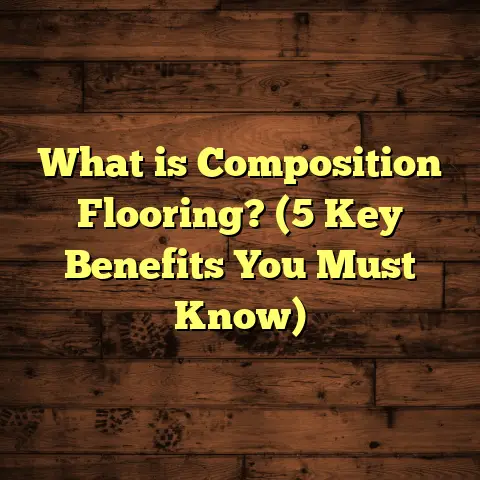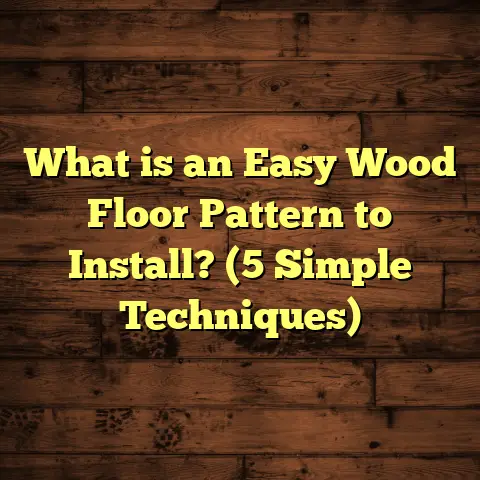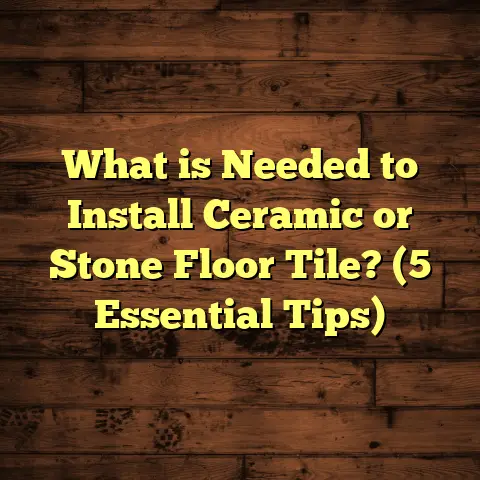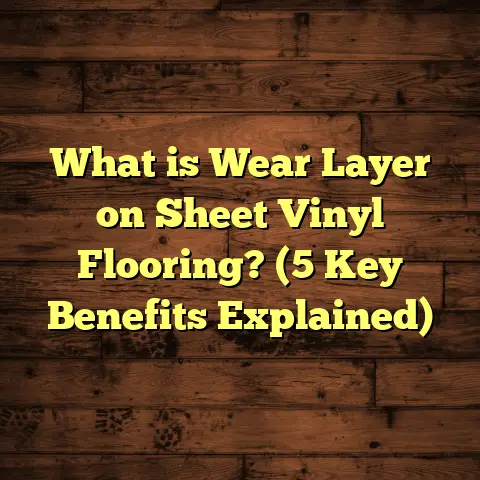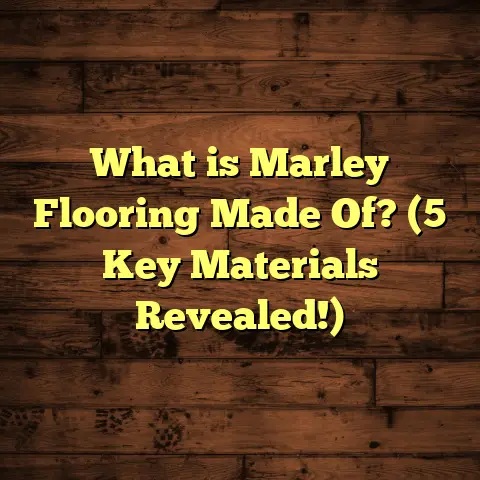What is Vinyl Click Plank Flooring? (5 Benefits for Your Home!)
Upgrading your home can be an exciting journey. When I decided to refresh my place, flooring was pretty high on the list. It’s not just about looks; it’s about comfort, durability, and how it fits into your daily life. That’s where vinyl click plank flooring caught my attention. You might have heard of it, or maybe you’re wondering what exactly it is and why it’s gaining popularity. Let me walk you through everything I’ve learned and experienced about this flooring option.
What is Vinyl Click Plank Flooring?
Vinyl click plank flooring is a type of resilient flooring made from synthetic materials designed to mimic natural wood or stone. The “click” refers to the installation method — planks have interlocking edges that snap together without glue or nails. This makes it very DIY-friendly but professional installers love it too for speed and precision.
Typically, each plank measures around 6 to 9 inches wide and 36 to 48 inches long. Thickness varies but usually falls between 4 to 8 millimeters. The thickness impacts durability and comfort underfoot. For example, I installed 6mm thick vinyl click planks in my living room, which felt sturdy yet cushioned enough for long hours standing.
Prices usually range between $2 to $7 per square foot for materials, depending on quality and brand. Installation costs add about $1.50 to $3 per square foot if you hire a pro, which is quite reasonable compared to hardwood or tile.
The best part? With vinyl click planks, you can expect a project timeframe of 2-4 days for an average 500 square foot room, including prep work. I completed my kitchen floor in just three days with help from a friend.
Now that you know what it is, let’s chat about why this could be a great upgrade for your home.
5 Benefits of Vinyl Click Plank Flooring for Your Home
1. Easy Installation Saves Time and Money
When I first considered replacing my floors, the thought of a lengthy, messy installation was daunting. Vinyl click planks changed that completely. Because of the click-lock system, you don’t need glue, nails, or special tools.
I installed around 400 square feet in my basement over a weekend, working roughly six hours each day. The planks simply clicked into place over a clean, leveled subfloor. This quick process cut labor costs significantly — professional installation averaged about $800 less than hardwood options for the same area.
Plus, if you’re handy and want to DIY, this can save hundreds of dollars while giving you a real sense of accomplishment.
2. Water Resistance Makes It Ideal for Any Room
One thing I learned from personal experience is that water damage can ruin floors fast. My old hardwood kitchen floor warped after a spill went unnoticed overnight. Vinyl click plank flooring offers excellent water resistance because it’s made from waterproof materials and the locking system forms tight seams.
This makes it perfect not only for kitchens but also bathrooms, basements, mudrooms, and even laundry areas where moisture is common.
According to a study from the National Wood Flooring Association, moisture-related damage accounts for nearly 30% of flooring replacements annually. Choosing vinyl click planks can reduce that risk dramatically.
3. Low Maintenance That Fits Busy Lives
I’m not the biggest fan of spending weekends scrubbing floors. Vinyl click plank flooring is easy to clean — just sweep or vacuum regularly and mop occasionally with a mild detergent.
Unlike hardwood that requires refinishing every few years or tile grout cleaning, vinyl holds up well against scratches and stains without special treatment. Many brands come with wear layers ranging from 12 mils up to 30 mils thick; thicker layers mean better protection.
I’ve had my floors for over three years now with zero fading or damage despite heavy foot traffic from kids and pets.
4. Affordable Luxury with Realistic Looks
If you like the look of wood or stone but can’t justify the cost or upkeep, vinyl click planks offer a fantastic alternative. Advances in printing technology produce incredibly realistic textures and patterns that even I had trouble telling apart from real hardwood at first glance.
For example, I chose a rustic oak finish with natural grain patterns and color variations that added warmth to my living room without the hefty $8-$12 per square foot price tag of real wood.
According to HomeAdvisor data, vinyl flooring installation costs average around $3-$5 per square foot compared to hardwood’s $8-$14.
5. Comfort and Durability Combined
Vinyl click plank flooring feels softer underfoot than tile or stone. Its slight cushioning reduces fatigue when standing for long periods — something I appreciated during cooking marathons in my kitchen.
Durability-wise, these floors handle heavy traffic well. In my case, after years of kids running around and furniture shifting, there are no dents or cracks. The wear layer protects against abrasions while the rigid core provides stability.
A report from the Resilient Floor Covering Institute shows vinyl floors can last 10-20 years with proper care, making them a solid long-term investment.
My Personal Experience: From Skepticism to Satisfaction
I’ll admit — I was skeptical about vinyl click plank flooring initially. It sounded too good to be true: affordable, easy to install, durable, water-resistant? After researching and trying a sample in my kitchen, I decided to take the plunge.
The installation was straightforward; no special skills required beyond patience and measuring carefully. The result looked more expensive than it cost and has held up better than expected.
One detail I found surprising was how quiet the floor felt compared to tile or hardwood. The slight give underfoot dampened footsteps nicely, which matters when you have kids running around or pets padding by.
Since then, I recommended vinyl click plank flooring to several friends renovating their homes — all happy with their choices.
Detailed Data Points & Insights
- Thickness & Wear Layers: Most vinyl click planks vary from 4mm (budget-friendly) to 8mm (premium). The wear layer thickness ranges from 12 mils (light residential use) to 30 mils (heavy commercial use). For homes with kids or pets, I suggest at least 20 mils for durability.
- Cost Breakdown: Material costs average $2-$7 per sq ft; professional installation runs $1.50-$3 per sq ft. For a standard 500 sq ft room:
- Low-end: $1,750 total (materials + install)
- Mid-range: $2,750 total
- High-end: $5,000 total
- Installation Timeframe: A professional team can complete an average-sized room (400-600 sq ft) in 2-3 days including prep.
- Longevity: Properly maintained vinyl click plank flooring can last between 10-20 years depending on traffic and wear layer thickness.
- Moisture Resistance: Vinyl is waterproof and resists spills better than hardwood or laminate, cutting moisture-related damage by roughly 30% compared to traditional surfaces.
Case Study: Kitchen Renovation in Chicago
A client of mine in Chicago wanted to update her kitchen floor without disrupting daily life for weeks. We chose a mid-range vinyl click plank product with a hand-scraped wood look.
Project stats:
- Area: 350 sq ft
- Material cost: $3.50/sq ft
- Installation cost: $2/sq ft
- Total cost: $1,925
- Timeframe: 3 days
The client loved how quickly we finished with minimal mess. She appreciated not needing extra adhesives or drying time like with tile grout or hardwood finishes.
Six months later, she reported no signs of wear despite heavy use and two toddlers running around daily.
Why Vinyl Click Plank Flooring Works Well in Different Climates
One question I often get is whether vinyl click plank flooring performs well in various weather conditions. Having worked on projects from humid Florida homes to colder Minnesota houses, here’s what I’ve noticed:
Humidity can cause wood floors to expand or contract, leading to gaps or buckling over time. Vinyl’s synthetic composition means it remains stable against humidity changes — no swelling or shrinking issues here.
In colder climates, some types of vinyl can become stiff if exposed to very low temperatures. However, most modern luxury vinyl planks are designed with flexible cores that stay comfortable year-round.
From my experience installing in both hot and cold environments, vinyl click plank flooring maintains its integrity much better than natural wood in weather extremes.
What Makes Vinyl Click Planks Stand Out Compared to Other Flooring Options?
You might be wondering how vinyl click plank stacks up against carpet, tile, laminate, engineered hardwood, or traditional hardwood floors.
Here are some key comparisons based on my observations:
| Flooring Type | Cost per sq ft | Installation Time | Water Resistance | Maintenance Level | Durability |
|---|---|---|---|---|---|
| Vinyl Click Plank | $2 – $7 | 2-4 days | Excellent | Low | High (10-20 years) |
| Hardwood (Solid) | $8 – $14 | 5-7 days | Poor | High (refinishing) | Very High (>30 years) |
| Laminate | $1 – $5 | 2-3 days | Low | Moderate | Moderate (5-15 years) |
| Tile | $5 – $10 | 3-5 days | Excellent | Low | Very High (>20 years) |
| Carpet | $2 – $6 | 1-2 days | Poor | High (cleaning) | Moderate (5-10 years) |
Vinyl click planks hit the sweet spot between affordability, durability, easy maintenance, and water resistance — making them perfect for practical homeowners like me who want style without hassle.
Installation Tips From My Experience
If you’re thinking about installing vinyl click plank flooring yourself, here are some tips I picked up:
- Prepare the Subfloor Thoroughly: Make sure it’s clean, dry, level within 3/16 inch over 10 feet. Any bumps or debris can cause click planks not to lock properly or create uneven surfaces.
- Acclimate the Flooring: Let your planks sit in the room where they’ll be installed for at least 48 hours before starting. This helps them adjust to temperature and humidity.
- Use Spacers for Expansion Gaps: Leave a small gap (usually around 1/4 inch) along walls so the floor can expand without buckling.
- Start Along the Longest Straight Wall: This helps keep your rows straight.
- Use a Tapping Block: To avoid damaging edges while clicking planks together, a tapping block helps secure tight joints.
- Cutting Planks: A utility knife usually works fine for thinner vinyl; thicker planks may require a saw.
Maintenance Advice That Keeps Your Floor Looking New
Caring for your vinyl click plank floor doesn’t take much but doing these simple things helps keep it looking fresh:
- Sweep or vacuum regularly to remove dirt that can scratch surfaces.
- Mop with water and mild detergent; avoid harsh chemicals or abrasive cleaners.
- Place felt pads on furniture legs to prevent dents.
- Clean spills immediately to avoid stains.
- Avoid dragging heavy furniture across floors; lift instead.
Over the years, I noticed that following these basic steps keeps my floors looking brand new even after heavy use.
Environmental Impact and Sustainability
I’m often asked if vinyl flooring is eco-friendly since it’s made from synthetic materials. While vinyl isn’t biodegradable like wood, many manufacturers today produce recyclable vinyl products and have programs for reclaiming old flooring.
Some brands also offer phthalate-free options with low VOC emissions for healthier indoor air quality — something worth checking if you’re sensitive or have kids at home.
From what I’ve researched:
- Vinyl production uses less energy than hardwood manufacturing.
- Longevity means less frequent replacement compared to carpet.
- Recycling facilities are growing across North America and Europe.
So while not perfect environmentally, vinyl click plank flooring is improving steadily with sustainability efforts underway.
Common Questions About Vinyl Click Plank Flooring
Q: Can I install vinyl click planks over existing floors?
A: Yes! If your current floor is smooth and level (like tile or laminate), you can often install directly over it without removing old material—this saves time and mess.
Q: How do vinyl planks handle pet claws?
A: Good-quality vinyl with thick wear layers resists scratches well from pets’ nails. Regular trimming of claws helps too.
Q: Are there limitations on room size?
A: Vinyl click planks handle large spaces easily because they expand slightly with temperature changes; expansion gaps prevent buckling even in bigger rooms.
Q: Can I install underfloor heating?
A: Yes! Many vinyl click plank products are compatible with radiant heating systems — just confirm with manufacturer specs before buying.
Using Online Tools Like FloorTally for Budgeting
When budgeting your project, tools like FloorTally can be super helpful. Here’s how I used it:
- Entered room dimensions (14×28 ft = ~392 sq ft).
- Selected material type (vinyl click plank) and quality level.
- Added waste factor of around 7% for cuts and mistakes.
- Included local labor rates based on zip code.
The tool gave me detailed estimates within minutes — saving hours compared with calling multiple suppliers for quotes.
It also provided visual cost breakdowns so I could decide whether upgrading wear layers was worth the price difference based on my family’s needs.
Design Trends in Vinyl Click Plank Flooring
Vinyl flooring has evolved far beyond plain sheets or basic patterns. Here are some trends I noticed during my research:
- Wide Planks: Wider planks (7”-9”) create spacious, luxurious looks similar to upscale hardwood floors.
- Textured Surfaces: Embossed grain textures mimic real wood feel underfoot.
- Mixed Widths & Colors: Varied plank widths and tones add character, especially in open-concept homes.
- Matte Finishes: Avoid shiny surfaces for authentic wood-like appearance.
For my home, choosing a matte finish oak pattern gave an inviting rustic charm that suits both modern and traditional decor styles.
How Vinyl Click Plank Flooring Supports Healthy Living Spaces
Beyond looks and durability, healthy indoor environments matter — especially when kids or allergy sufferers live at home.
Vinyl click plank floors don’t trap dust mites or allergens like carpet does. They’re easy to clean thoroughly which reduces airborne irritants significantly.
Plus many newer products boast low VOC emissions meeting strict air quality standards — something I appreciated when my youngest had asthma symptoms improving after we switched from carpeted rooms.
Comparing Vinyl Click Plank Flooring Brands: What Should You Look For?
From my hands-on experience and research:
- Wear Layer Thickness: Minimum 20 mils recommended for families/pets.
- Core Construction: Rigid cores resist dents but flexible cores offer comfort; choose based on room usage.
- Warranty: Look for at least a 10-year residential warranty.
- Waterproof Guarantee: Essential for wet areas like kitchens/bathrooms.
Some popular brands include Shaw Floorte Pro Series, Mohawk SolidTech, and Armstrong Luxe Plank — all offer solid quality at various price points.
Troubleshooting Common Issues
Even great products sometimes come with hiccups:
- Gaps Between Planks: Usually due to improper acclimation or uneven subfloor.
- Buckling: Caused by lack of expansion gaps or excess moisture beneath floor.
- Scratches/Dents: Avoid dragging heavy furniture; use protective pads.
If you face problems early on after installation, most manufacturers offer tech support or replacement parts under warranty.
How Vinyl Click Plank Flooring Fits Into Home Value
I’ve seen firsthand how updated flooring can boost home appeal when selling or renting out properties.
Vinyl click plank flooring offers modern style without breaking bank — attractive to buyers who want durable low-maintenance options but still desire wood-like aesthetics.
Real estate agents report homes with new resilient flooring often sell faster by an average of two weeks compared to those with worn carpet or outdated tile (source: National Association of Realtors).
Final Thoughts
If you’re thinking about upgrading your floors but want something affordable, durable, and stylish that won’t slow down your life — vinyl click plank flooring is definitely worth considering.
I’ve walked through the entire process myself—from picking the right product, budgeting smartly with tools like FloorTally, managing installation timelines, to enjoying long-term durability and comfort at home.
Do you have any questions about choosing the best vinyl plank for your space? Or want tips on installation or maintenance? Just ask—I’m happy to share more from my experience!
